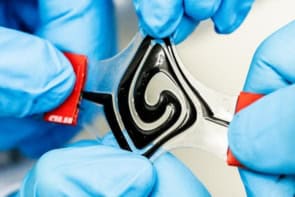
Researchers in China have made lead halide perovskite solar cells more stable by changing the chemical used to process the precursors from which they are made. The switch could make it easier to commercialize this type of solar cell as it makes it less likely for the material to form phases that reduce the cells’ ability to convert sunlight to electricity.
Halide perovskites are crystalline materials with an ABX3 structure, where A is caesium, methylammonium (MA) or formamidinium (FA); B is lead or tin; and X is chlorine, bromine or iodine. They are promising candidates for thin-film solar cells because they are easy to manufacture and can absorb light over a broad range of solar spectrum wavelengths thanks to their tuneable bandgaps. Charge carriers (electrons and holes) can also diffuse through them quickly and over long distances. These excellent properties have enabled researchers to make perovskite solar cells with a power conversion efficiency (PCE) that exceeds 25%, placing them on a par with established solar-cell materials such as silicon, gallium arsenide and cadmium telluride.
If all this sounds too good to be true, that’s because it is. Unfortunately, perovskite solar cells are also unstable at room temperature and ambient humidity. This is obviously something of a drawback for solar panels, which need to be exposed to weather to convert sunlight into electricity.
PCEs up to 25.5%
In the new work, a team led by Yaowen Li of the National Science Foundation of China focused on the perovskite formamidinium lead triodide (FAPbI3). This material is one of the best perovskite candidates for making high-performance solar cells, as its small bandgap relative to its chemical cousin methylammonium lead triiodide (MAPbI3) makes it more thermally stable and capable of absorbing solar light over a broader range of wavelengths. In 2019, researchers made solar cells from FAPbI3 with PCEs of 23.7%. More recently, this certificated PCE value was increased up to 25.5%.
High-quality films of FAPbI3 are usually made from a precursor solution, or ink, containing an additive of methylammonium chloride (MACl). The problem is that this additive decomposes into methylamine, forming unwanted phases such as δ-FAPbI3 that destroy the photovoltaic performance of FAPbI3.
Li and colleagues realized that they could overcome this problem by replacing MACl with caesium chloride (CsCl), as this additive does not form unwanted phases. To test their hypothesis, the researchers compared the stability of a solution of FAPbI3 containing either MACl or CsCl precursors. They found that each additive works well for making high-quality FAPbI3 films, resulting in efficient carbon-electrode perovskite solar cells. However, the solution containing MACl is unstable and degrades within a week because it decomposes into methylamine. The solution containing CsCl, in contrast, remained stable for over a month.
Tandem solar cells edge towards 30% efficiency
“Our work shows that there is a great need to develop non-MACl FAPbI3 perovskite precursor solutions for the cost-effective preparation of perovskite solar cells,” Li says. “These will help bring perovskite solar cells closer to commercialization.”
The researchers, who report their work in Chinese Physics B, tell Physics World that they now plan to print stable and efficient large-area perovskite solar modules based on their durable perovskite ink.



